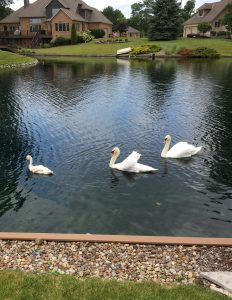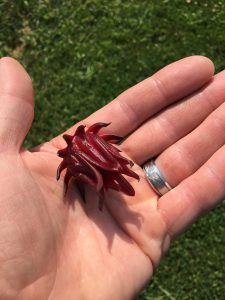I want to thank Bob and Lori Everett for hosting the Master Gardener Volunteer Gathering on Friday. These quarterly gatherings are a way for us to visit, share a meal, get updates about the MGV program, and learn something. The next one is coming up September 29 so make plans to attend. In case you couldn’t make it, here is what we learned.

My wife and I just bought a new house. Before we even met any of the neighbors I could tell how things operated in the neighborhood. In fact, all I had to do was look around. You could see how people kept their lawn and the outside of their homes, and this was particularly helpful when it came to a privacy screen.
We live on a ¼ acre lot in town and our backyard is open to all the neighbors. My wife and I both lived in the country prior to getting married, so the idea that our neighbors could see us sitting on the patio was a little different, not something we were used to. So I thought about putting up a fence, then I looked around to see what everyone else had done. To my shock no one had a fence and almost no one had a hedge.
Suddenly, putting up a fence doesn’t seem like a very good idea.
If you are like me, you look around to see what other people are doing before you do something yourself. Maybe you watch your neighbors or maybe you look things up on YouTube, or ask a friend how to do something. These things can be so helpful in learning how to do something (Just look at Pinterest).
We even tend to do the same thing when it comes to gardening, don’t we? We look around to see what other people are doing in order to know what we should be doing in our own yard. This can be helpful, but only for so long because, sometimes your neighbors can be wrong. Sometimes, YouTube can be wrong, and sometimes even your friends can be wrong.
Someone told me the other day that they watch what we do at Secrest and then do it at their own house. So let’s ask the question, what should we be doing in our gardens right now? I mean, what should we do to keep our gardens looking great? It is the time of year where we like to entertain outside and want things to look nice, so what should we do?
Well, here are 7 things we are doing at Secrest that you should be doing in your own yard.
1. Deadhead
Deadhead perennials like catmint, salvia, coreopsis, sea thrift. Remove spent flowers from woody plants like spirea to encourage a light second bloom. Deadheading helps to tidy up the garden and encourages some plants to rebloom.
2. Prune
Now is a great time to be doing summer pruning. By now plants have put on a decent amount of growth. Take some time to shape them and remember to follow proper pruning techniques. Do not perform any major structural pruning now. Trees can be limbed up. Cease pruning activities by August 15.
3. Weed
Scout for weeds, especially weeds that are about to seed or are difficult to control. Weeds such as canada thistle, groundsel, prickly lettuce are all beginning to seed. If they are starting to release seeds in your garden, carefully cut seed heads and bag them to prevent the seeds from spreading.
Look for Marestail and pokeweed, weeds that are difficult to control and may require digging to remove them. They also blend in well with other plants so be on the lookout for them.
4. Fertilize
Fertilize your annuals and containers because these plants are heavy feeders and need fertilizer to get them through the summer. Containers especially benefit from a 5-10-5, 10-10-10, 12-12-12 fertilizer or the application of osmocote. You should only apply a liquid fertilizer or slow release to your annuals.
5. Compost
Pull your lettuce and spinach that are starting to bolt and add them to your compost pile. You can also add yellowing garlic stalks to the pile after you have pulled them. Continue to add to the pile throughout the season and turn it on a monthly basis. According to the Lorian County Extension Website, “It is suggested that about 75% (by volume) of the materials added to a compost pile are brown, and 25% are green” (https://lorain.osu.edu/compost).
6. Scout for Insects and Diseases
Fall webworms and Japanese Beetles are starting to show up. Bagworms may be present in low numbers this year. It is best to control bagworms when the catalpa trees bloom. The application of a pesticide now might control some of the insects, but it is not going to be as effective as an early application. Always remember to follow the label on all pesticides.
Powdery mildew is showing up on coreopsis. This fungal disease can make the plant look bad but will generally not kill the plant.
7. Water
New trees and shrubs need 1” of water per week to get established. Track rainfall with a rain gauge and add supplemental water as needed.
There you have it. Seven things you should be doing in your garden right now. I know some of you are doing some of these already, and some of these tips are new. So which one should you be doing?











